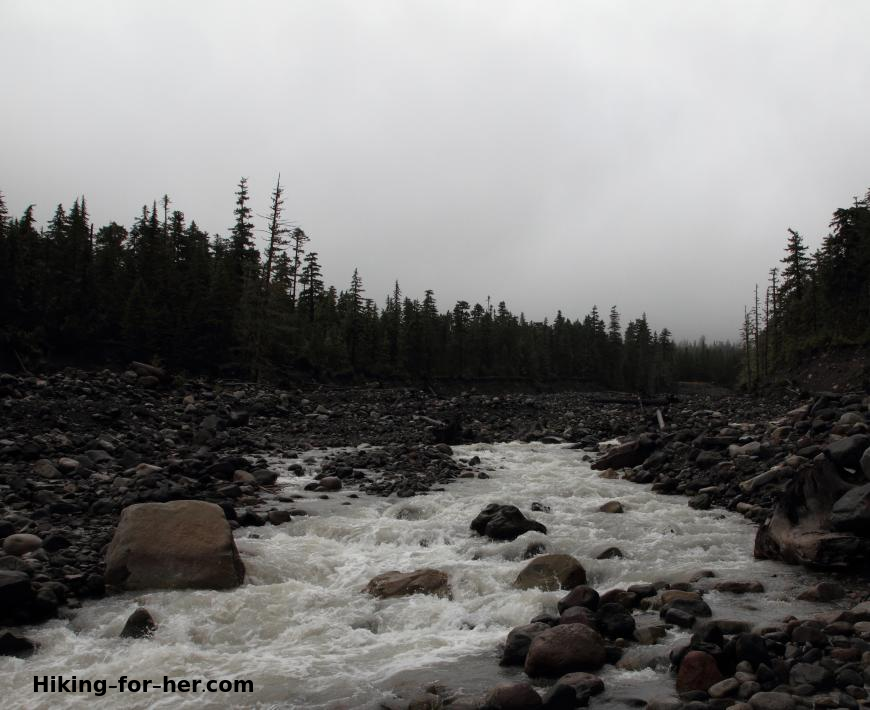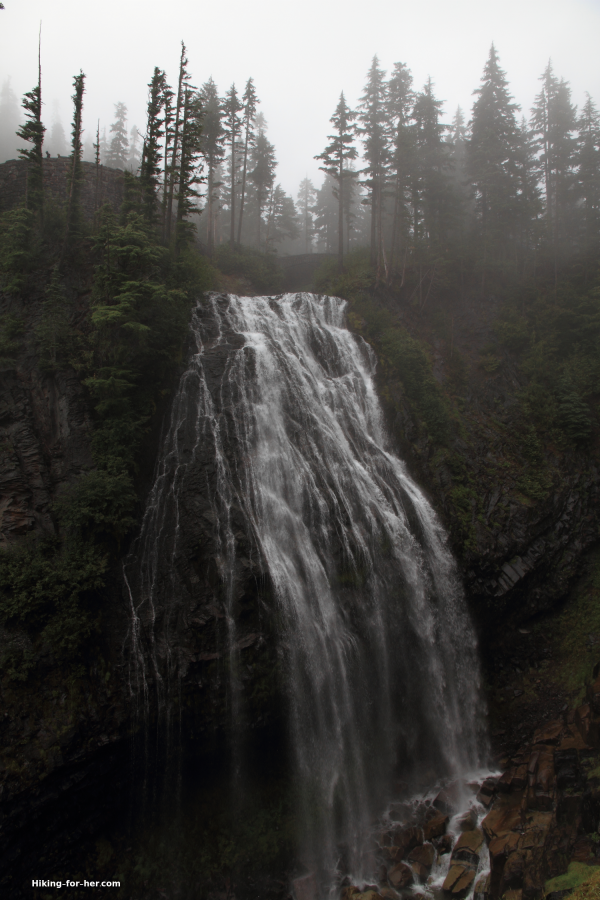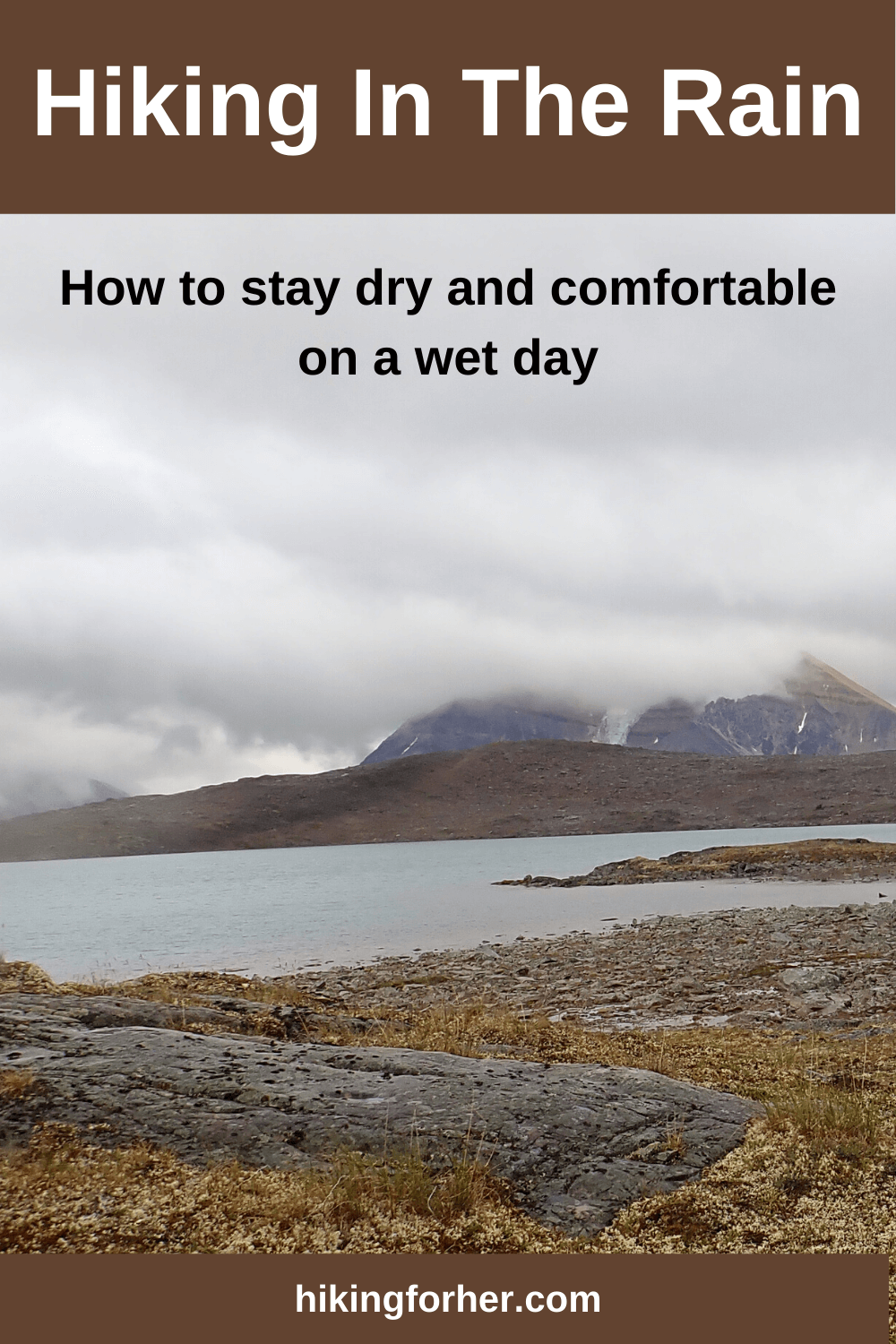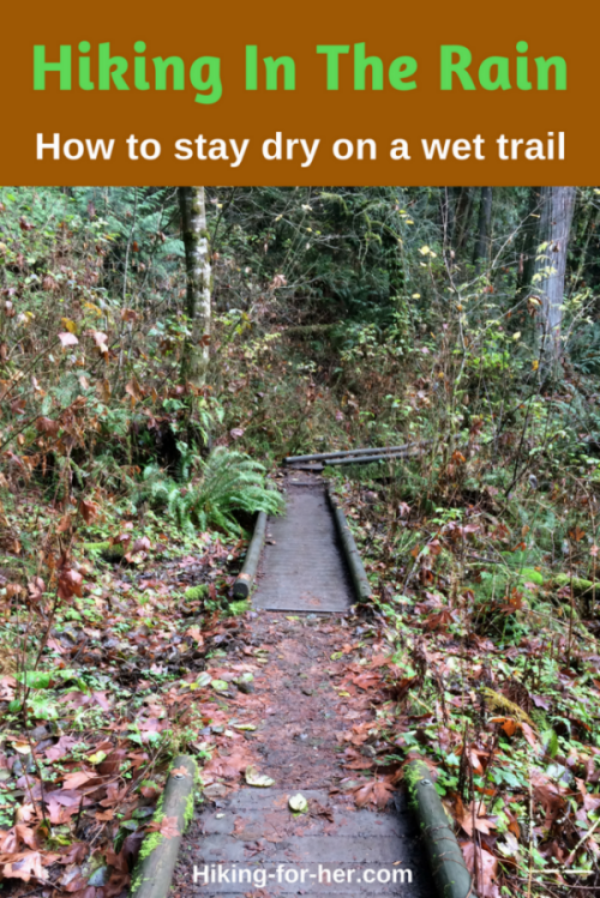
Rainy Day Hiking Tips:
Be Safe And Happy
Even On Wet Trails
By Diane Spicer
Rainy day hiking can be a predicament if you're on a rainy multi-day backpacking trip.
Or you can make a conscious choice to enjoy a rain hike on a soggy day.
Either way, you need to know how to stay dry when everything around you is wet.
As a veteran of some of the wettest hiking in the northern hemisphere (Washington State, western Canada, Alaska), I've got some strategies for how to stay dry on a wet hike.
Let's break them into two steps, both of which you control:
1. What to wear to stay dry on a hike
2. What to do to avoid becoming a sponge on the trail
Rainy day hiking:
your gear choices
When you step into the shower or a swimming pool, your goal is to get wet.
But when you step onto a dripping wet, muddy hiking trail, you're hoping your footwear and clothing will meet the challenge of resisting, repelling, or excluding moisture from your body.
This is no trivial matter.
Your body heat and well being are going to be challenged by the wet conditions.
That's why you need the best rain gear.
But know this: there are several things working against moisture resistant hiking gear:
- the ability of the material or fabric to exclude water molecules from contacting your skin
- leaky seams & zippers
- points of entry for water that can't be sealed, such as neckline, wrists, cuffs
In addition, you will be generating heat and sweating (like the delicate flower that you are) as you hike, regardless of how cool the day might be.
- Essentially, you will be "raining" inside your hiking clothing.
What to do?
Make smart choices!
How to choose the right rain gear
for your hiking plans
There are 3 levels of moisture resistance built into hiking gear:
- water resistant
- water repellent
- water proof
Read more about the differences here.
Some examples of matching your hiking rain gear to your plans:
If you are doing a short day hike with plenty of opportunity to turn back when you get too wet, or can duck under tree cover if it begins to pour, you don't need waterproof hiking clothing - unless you want it.
- Water repellent clothing (less expensive) is good enough.
If your rainy day hiking plans involve lots of mileage in open terrain, whether on a day hike or backpacking trip, you would be wise to invest in high quality waterproof hiking gear.
- No shelter or cover, no chance to dry out, these will take a toll on your body and your attitude.
Keep your feet
as dry as possible
I'm here to deliver the sad news that no matter what you have on your feet, eventually they will get wet during rainy day hiking.
So be realistic.
Consider not only how long a pair of hiking boots or trail shoes will keep your feet dry, but how long they will take to dry out again.
This becomes absolutely crucial on a backpacking trip in cool or downright cold wet conditions.
- Slogging along day after day in wet, cold hiking boots sets you up for foot problems such as blisters and abrasions.
- It might also lead to foot cramping, which for a hiker is one of the worst fates imaginable on a backpacking trip.
You will have to trust the boot manufacturer's technical specifications about which boots are water repellent -vs- water proof.
- Read carefully for the words "water proof".
Tips for dry feet on a wet day:
- Wear gaiters over your pants and footwear, and cinch them down tightly to deprive water any direct entry points.
- Before donning your gaiters, pull on hiking pants with cuffs that cinch down tightly around your ankles.
Protect your head and neck
from damp conditions
It's silly to get your head and neck wet, yet I see hikers all the time who hike in the rain without protection.
Think of all of the body heat they freely give to the universe!
And how they're courting a disaster called hypothermia.
But you're smarter than that.
Here's how to avoid getting chilled:
- Always choose a hiking jacket with a hood which tucks away on a sunny day into its own little zippered compartment at the neckline.
- The hood should have an overhang above your eyes, rather than snug down around your face.
- The wrists of your jackets should have adjustable straps, or at the very least, an elastic cuff to protect your shirt from moisture.
- Carry at least two types of hats on any hike with a possibility of rain (and depending on where you hike, that means every single one): a hat with a brim so rain will stay out of your eyes, and a hat that cinches down around your ears while fitting easily beneath your hood.
- If you're prone to feeling chilled easily, add a thin sports headband to your gear. It weighs nothing yet provides a lot of heat retention on your head.
- Your jacket should zip up completely around your neck, with a soft chin guard (piece of fabric which covers the zipper on the inside to avoid abrading your skin).
- Pit zippers (guess where those are) and short chest zips
(offset from the midline) give you the ability to control your
temperature, which is lovely when it's cold outside but tropical inside
your jacket.
- A neck gaiter underneath your jacket can be added, but it will keep you mighty toasty and could give a feeling of being strangled if your jacket is too snug.
- Use a hiking umbrella!
For more details on jackets for women which perform well on a hike, go here.
Your torso
needs some attention, too
Most of your vital organs are housed within your torso, so your body devotes a lot of resources to keeping them at a constant temperature:
- elaborate blood flow networks
- layers of adipose (one place on your body you should appreciate your fat layers)
Keep that strategy going by choosing layers which wick your sweat away from your skin while preventing contact with outside cold moisture.
To see which layers I choose, read this.
I'll bet you've already thought about hiking vests!
But wait, there's more!
Waterproof hiking rain pants
The final step you can take to keep yourself as dry as possible while hiking in the rain is to keep your legs dry.
Hiking gaiters will help keep your lower legs dry.
Waterproof hiking pants will deal with the run off created from your hiking jacket and backpack, as well as shield you from blowing rain or wet vegetation.
Here's where it makes good sense to spend a little money for your comfort and safety in wet hiking conditions.
My all time favorite hiking rain pants are these.
- I've had them for years, punished them on brutally wet backpacking trips, and can't find a single negative thing to say about them.
- And recently reviewed my lightweight pair here.
And don't overlook the power of duct tape to patch up the butt when you eventually snag them on something stronger than they are :)
Rainy day hiking:
behavioral choices
 Gray skies spitting on you? Hike anyway, but have a plan.
Gray skies spitting on you? Hike anyway, but have a plan.One way to avoid rainy day hiking is to build flexibility into your hiking itinerary.
On
a day hike, that means having a Plan B if it starts dumping rain: an
alternate hike with plenty of dense tree cover, for instance.
For backpackers, scheduling at least one, if not more zero days, rest days, rain days (whatever you want to call them) is the best way to deprive Mother Nature of the chance to get you soaked.
- Or keep you wet and cold for days on end.
Another trustworthy tip
for hiking in the rain
During the rainy season (whatever that is in the region you plan to hike), use trails with shelters for taking a break, or for camping.
- Check with the organization that has jurisdiction over your hiking location for the availability of shelter.
- If
a permit system is used, be sure to secure the proper permission or
risk being turned out into the cold, dark, rainy night in your soggy
tent.
Here's an example from Isle Royale National Park in Lake Superior:
- There are screened shelters at most points along the trail. What a blessing to get in out of the rain!
More rainy day
hiking tips for you
Attitude is all
There are some hikers who can handle being cold and soggy, day after day.
And there are some hikers who become bitter and hostile (and woe to you if you're stuck in a tent with one).
If you're a beginner hiker, I recommend that you allow yourself one good soaking hike to determine which category you fall into, and then go from there.
No shame in hiking only in sunny, dry conditions!
- I hear Arizona hiking is nice ;)
But if rain jazzes you up, Pacific Northwest hiking is definitely for you!
- Plan some hikes with these PNW resources.
- Enjoy these 3 absolutely stunning Mt. Rainier day hikes.
- Or plan a longer hiking adventure at Mount Rainier.
Accept this fact:
some things can't be avoided
Might as well share all of it with you!
There are some things that will annoy you that cannot be avoided when you hike in the rain.
And that can make rainy day hiking miserable.
Examples:
If you wear glasses, they will fog up and collect moisture. It will be harder to see through them.
- Carry a chamois cloth in an outer zipped pocket.
Your nose will start to run and drip.
- Tissues get soggy, so carry a bandanna in an outer pocket which is devoted to this task.
- I probably shouldn't say this, but in a pinch, your neck gaiter can be pressed into runny nose service.
Sweat will run down your neck and back if you're hiking hard. "Raining on the inside" does not feel that great but is survivable.
- Choose the breathable rain gear you saw earlier in this article to minimize the problem.
Once your socks get wet, your toes will squish and may even slide around inside your boots.
- Wrinkled prune toes will be your souvenir of a rain hike.
- At least it washes the grunge out of your toenails ;)
Your electronic navigation and communication devices may not work if they get wet.
- Waterproof self sealing containers are preferred over plastic bags for this reason.
Now you know the discomforts of hiking in the rain!
Have a rainy day
hiking plan
Knowing that discomfort is just part of the fun, make a plan for what you're going to do when taking one more step on the trail is NO FUN AT ALL.
Because sooner or later, you're going to asking yourself why the -bleep- you're hiking in the rain.
Here are some tricks to try.
Can you stop for a break without getting even wetter?
- Eat something, sip water, readjust your clothing and remind yourself that you're having a (rainy) adventure.
Can you turn around and get back to a drier, warmer space in a timely manner?
- As you hike briskly, you'll begin to dry out your inner and mid layers from your body heat.
Should you press on a bit further to reach a campsite or shelter marked on the map?
- Check your map or navigational aid in its waterproof case, and determine what makes the most sense for you.
Do you have dry clothing inside your pack that would make you feel more comfortable?
- Only open your pack and strip off wet clothing if you're protected beneath tree cover or rock overhangs.
Can you provide your own shelter?
- A backpacking tarp can be set up quickly to provide some shelter on rainy but not windy days.
Learn a few new tricks
from every rain hike
Because there is a highly personal learning curve to hiking in the rain, I recommend keeping notes in a (wait for it...) waterproof hiking journal.
Record what you did right, which rain gear performed well, which food kept your furnace stoked.
Also make notes on what needs to be abandoned, improved, or tweaked.
It's the best way possible to gain entry into that elite group of hikers who love, love, love rainy day hiking.
Or to arm yourself against the onslaught of Mother Nature's precipitation.
Either way, you're on the trail and loving life!
Rainy day hiking can be fun
No, seriously
There's something magical about the earthy, vegetal odors during a rainy day hike.
Animals behave differently when it rains.
Chances are good that you will have amazing trail encounters that wouldn't be possible on a dry day.
- My guess is that rain dampers a large mammal's ability to smell, allowing you closer proximity to their mysterious habits.
On the flip side, human trail traffic tends to drop to almost nothing during a rainy spell, so you'll have all of the glory of rainy day hiking to yourself.
 Do something wild during rainy day hiking: stand in the spray of a rushing waterfall as the rain falls out of the sky!
Do something wild during rainy day hiking: stand in the spray of a rushing waterfall as the rain falls out of the sky!
Head out in the wonderful world
of rainy day hiking
With these tips on what to wear on a rain hike & how to stay dry during rainy day hiking, you won't have to stay indoors when it starts to rain.
You will be a Puddle Stomping Hiker Extraordinaire!
More self care hiking tips you can use here
Home page > Best Hiking Tips >
Rainy Day Hiking Tips
|
I get emails all the time about what I wear, eat, carry and love to use on the trail. That's
why I provide affiliate links to you: the best gear that I use myself and have seen used by other hikers is instantly
available for your consideration, and the gear company sends a few
pennies per dollar to this reader-supported hiking website. There is no added cost to you! Everyone ends up a winner: Great gear for you, strong gear companies, and more free hiking tips for everyone. Thanks very much for your support. It's warmly and sincerely appreciated. It also helps send these hiking tips to all your virtual trail buddies around the globe. |
 |



